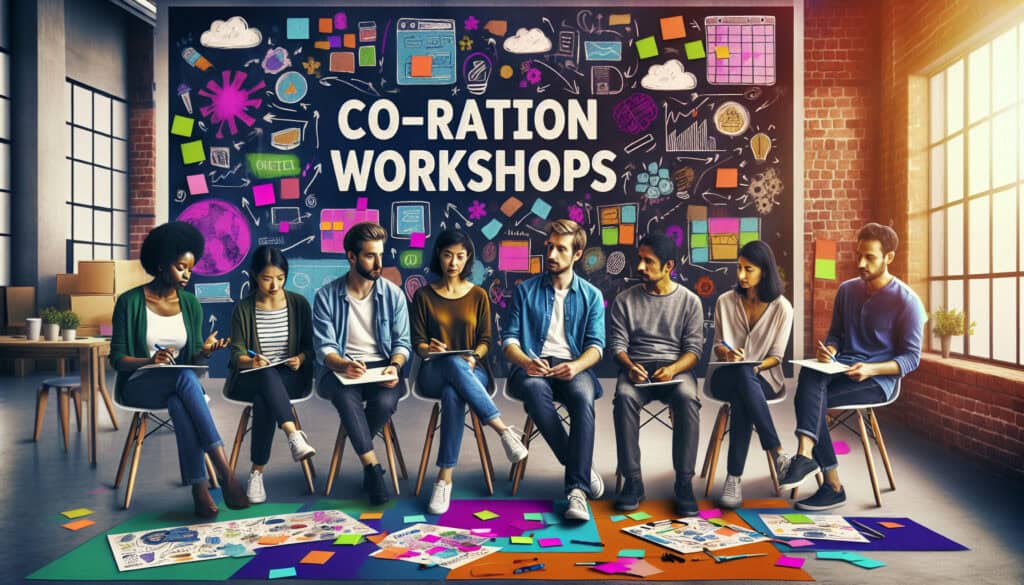Collaborative sessions where a company and its stakeholders (such as customers, partners, or employees) work together to generate ideas, solve problems, or design a product.
- المنهجيات: الهندسة, بيئة العمل
Co-Creation Workshops

Co-Creation Workshops
- المنهجية الرشيقة, تجربة العملاء, التفكير التصميمي, التصميم المرتكز على الإنسان, ابتكار, تصميم تفاعلي, تصميم يركز على المستخدم
الهدف:
كيفية استخدامه:
- These are facilitated, interactive الأحداث designed to harness the collective creativity of a diverse group of people to produce innovative and user-centric outcomes.
الايجابيات
- Generates more user-centric ideas, builds stronger relationships and loyalty with customers, and can lead to more innovative and successful products.
سلبيات
- Can be logistically complex and expensive to organize, requires skilled facilitation to be productive, and managing diverse opinions can be challenging.
الفئات:
- العملاء والتسويق, الأفكار, تصميم المنتج
الأفضل لـ
- Actively involving customers and other stakeholders in the innovation and design process.
Co-Creation Workshops are utilized across various industries such as consumer electronics, automotive, healthcare, and software development, often conducted during the early phases of product design or during iteration cycles. These workshops typically involve diverse participants, including customers, stakeholders, designers, engineers, marketing professionals, and subject matter experts, allowing for a multidimensional approach to problem-solving. The methodology encourages participants to engage in brainstorming activities, sketching, prototyping, and role-playing scenarios, which can yield rich, contextualized insights into user needs and preferences. These workshops not only enhance the creative process but also serve to break down silos between departments, fostering collaboration and communication across different functions of an organization. In the healthcare sector, for example, co-creation can lead to improved medical devices that better cater to patient experiences, while in the tech industry, it can drive the development of software that aligns more closely with user expectations. Such collaborations are initiated typically by product managers or innovation leads who recognize the potential impact of customer involvement in shaping solutions. Further, the approach can lead to stronger brand loyalty, as customers feel more invested in products that reflect their input, engendering a sense of ownership that translates into ongoing support and advocacy for the brand.
الخطوات الرئيسية لهذه المنهجية
- Define clear objectives for the workshop.
- Facilitate brainstorming sessions using techniques like mind mapping or ideation sprints.
- Encourage open dialogue and interaction among participants.
- Utilize prototyping tools or paper mock-ups for rapid idea visualization.
- Conduct breakout sessions for focused discussion on specific topics or challenges.
- Guide participants in prioritizing ideas through voting or affinity diagrams.
- Document key insights and concepts in real-time for immediate feedback.
- Build consensus on the most promising ideas for further development.
- Engage in creative play to stimulate new perspectives and approaches.
نصائح للمحترفين
- Utilize role-playing scenarios during co-creation to uncover tacit knowledge and perspectives that may not surface in traditional discussions.
- Implement rapid prototyping within workshops to allow participants to visualize ideas immediately, speeding up feedback loops and refining concepts effectively.
- Incorporate diverse stakeholder الناس to ensure a broader range of needs and preferences is represented, enhancing the richness of the ideation process.
لقراءة عدة منهجيات ومقارنتها, نوصي باستخدام
> مستودع المنهجيات الشامل <
مع أكثر من 400 منهجية أخرى.
نرحب بتعليقاتكم على هذه المنهجية أو المعلومات الإضافية على قسم التعليقات أدناه ↓، وكذلك أي أفكار أو روابط متعلقة بالهندسة.
السياق التاريخي
1949
1950
1950
1960
1960
1960
1960
1940
1950
1950
1958
1960
1960
1960
1960
(إذا كان التاريخ غير معروف أو غير ذي صلة، على سبيل المثال "ميكانيكا الموائع"، يتم تقديم تقدير تقريبي لظهوره الملحوظ)















منشورات ذات صلة
جدول الإنتاج الرئيسي (MPS)
التخصيص الشامل
قمع التسويق
التدقيق التسويقي
مؤشر MAPO (حركة ومساعدة مرضى المستشفيات)
تخطيط موارد التصنيع (MRP II)